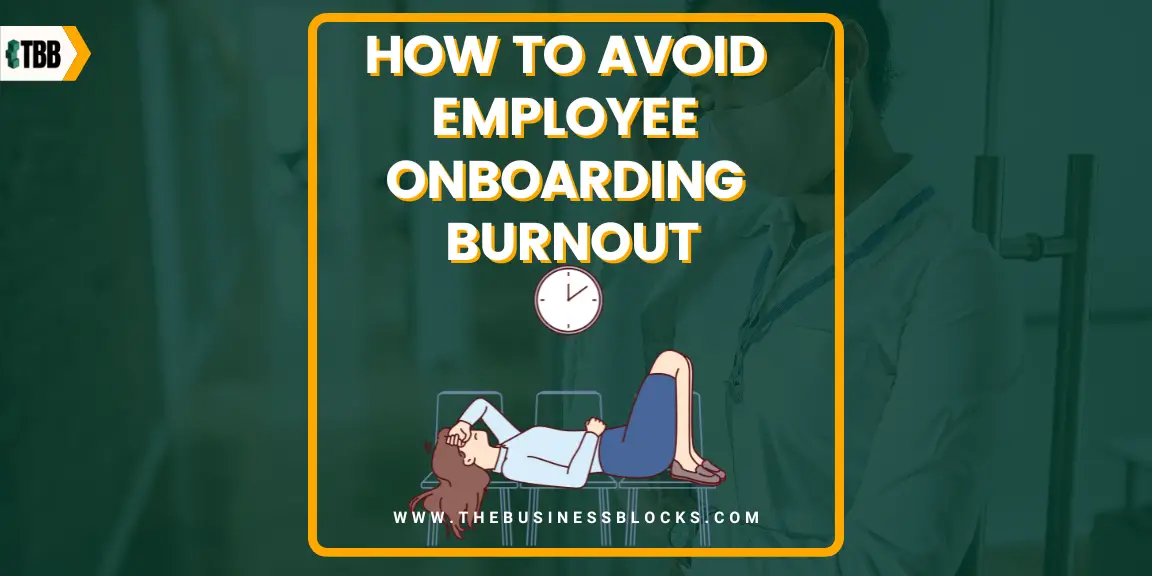Running a successful business requires setting up your employees for success as they join the team. Onboarding is a critical element of that process. Still, it can also be stressful and overwhelming for new hires, leading to burnout before they’ve had an opportunity to become truly integrated into their workplace. To ensure positive onboarding experiences for employers and employees, risks associated with employee onboarding burnout must be identified and managed effectively.
Are you Dealing with Employee Onboarding Burnout?
Holistic employee onboarding is essential for building a successful and engaged team. However, without the right approach, it can be overwhelming to manage numerous tasks while introducing new employees to their roles and the workplace culture.
Let us help you learn how to increase efficiency and reduce burnout during this initial transition period – with our comprehensive guide on How To Avoid Employee Onboarding Burnout! We’ll provide proven best practices to streamline the onboarding process so you can focus less on administration and more on developing your talented staff.
Did you know?
- burnout is a syndrome resulting from workplace stress that has not been successfully managed- WHO
- A recent survey by the American Psychological Association examined 1,501 workers, with 79% experiencing burnout at their current job
What is Employee Onboarding?

Employee onboarding introduces and orientates new employees to their job, workplace, team, and company. It typically involves orienting employees to the company culture, introducing them to key personnel, and setting up any necessary equipment or technology for their work. Onboarding also helps employees become familiar with their job duties, expectations, and performance standards.
By properly introducing and orienting your new employees, you can set them up for success in their new roles and reduce turnover rates. During the process, it is important to provide employees with feedback to ensure they feel supported and valued by the organization. Ultimately, employee onboarding helps create a better work environment for all involved.
Understanding Employee Onboarding Burnout
Employee onboarding burnout refers to the exhaustion and stress that new hires experience during the onboarding process. It can occur when employees feel overwhelmed by the information, expectations, and demands placed on them during the initial stages of their employment. This can result in a lack of engagement, decreased job satisfaction, and even turnover.
During onboarding, employees must absorb information quickly, adapt to a new work environment, and establish colleague relationships. This can be particularly challenging for new hires, also dealing with the pressure of starting a new job and meeting performance expectations.
Addressing employee onboarding burnout is important for several reasons.
- Firstly, it can impact the overall success of the onboarding process. When new hires feel overwhelmed and stressed, they may be unable to retain the information or build the relationships necessary for success in their new role. This can result in lower productivity and slower integration into the company culture.
- Secondly, employee onboarding burnout can hurt employee engagement and job satisfaction. When new hires struggle to cope with the onboarding process’s demands, they may question their decision to join the company or feel disillusioned about their prospects for success. This can lead to lower morale and a higher likelihood of turnover, which can be costly for the organization regarding recruitment and training.
Addressing employee onboarding burnout is critical for creating a positive onboarding experience and setting new hires up for success in their new roles. By recognizing the potential for burnout and implementing strategies to mitigate it, organizations can ensure that new employees can thrive in their new positions and contribute to the company’s success.
The Common Causes of Employee Onboarding Burnout

Employee onboarding burnout can have various causes, but some of the most common include the following:
- Long and Overwhelming Onboarding Processes: When onboarding processes are too long and complex, employees may become overwhelmed and exhausted, leading to burnout. This is particularly true if the onboarding process is not well-organized and lacks clear objectives.
- Insufficient Training and Support: Employees who do not receive adequate training and support during onboarding may feel frustrated and overwhelmed, leading to burnout. Lack of guidance, feedback, and mentoring can make new hires feel lost and uncertain, and they may struggle to adapt to their new role.
- Unclear Expectations and Objectives: If new employees are not provided with clear expectations and objectives during onboarding, they may feel lost and unsure of what is expected of them. This can lead to burnout as they struggle to figure out what they should be doing and how they can succeed in their role.
- Poor Communication: When communication is poor during onboarding, employees may feel disconnected and unsupported, leading to burnout. This can happen if managers and colleagues are not responsive to new hires’ questions and concerns or if there are inconsistencies in the messages being communicated.
- Unrealistic Workload: Setting unrealistic expectations or assigning an excessive workload to new employees can quickly lead to burnout. This can happen when managers assume that new hires can perform at the same level as experienced employees without providing the necessary training and support to help them get up to speed.
Employers need to recognize that onboarding is a critical time for new employees, and providing them with the support and resources they need to succeed is essential. By addressing these common causes of burnout during onboarding, employers can help ensure that new hires can successfully transition into their new roles and avoid burnout.
What are the Signs and Symptoms of Employee Onboarding Burnout?
Employee onboarding burnout can occur when new employees feel overwhelmed, stressed, and exhausted during the onboarding process. Some signs and symptoms of employee onboarding burnout include:
Physical Symptoms:
- Fatigue and exhaustion
- Headaches or migraines
- Insomnia or sleep disturbances
- Increased illness or vulnerability to illness
- Changes in appetite or weight
Emotional Symptoms:
- Anxiety or depression
- Irritability or mood swings
- Feelings of helplessness or hopelessness
- Lack of motivation or interest in work
- Reduced self-esteem or confidence
Behavioral Signs:
- Absenteeism or tardiness
- Reduced productivity or quality of work
- Resistance to change or learning new things
- Increased mistakes or errors
- Withdrawal from social interactions or team activities
The impact of employee onboarding burnout on performance and retention can be significant. Burnout can lead to decreased productivity, work quality, and job engagement. It can also lead to increased absenteeism, turnover, and job dissatisfaction.
If left unaddressed, employee onboarding burnout can negatively impact the employee’s long-term success and the company’s overall success. Therefore, monitoring new employees’ well-being and providing support and resources to prevent burnout is essential.
5 Best Strategies to Prevent Employee Onboarding Burnout

Employee onboarding is critical for new hires as they adapt to their new roles and integrate into the organization. However, the onboarding process can be overwhelming and stressful, leading to employee burnout. Here are some strategies to prevent employee onboarding burnout:
1. Schedule Regular Check-Ins
Schedule regular check-ins with new employees to gauge their progress, provide feedback, and ensure they are not overwhelmed or feeling burned out. Regular check-ins can help identify issues early and prevent them from escalating into bigger problems.
2. Streamlining Onboarding Processes
Streamlining the onboarding process can help reduce stress and prevent burnout. Clear instructions, resources, and training materials can help new employees feel more comfortable and confident.
3. Providing Clear Guidance and Feedback
Clear guidance and feedback can help new employees understand what is expected of them and how they perform. Clear feedback can also help employees feel more engaged and motivated.
4. Offering Opportunities for Socialization and Team Building
Encouraging socialization and team-building activities can help new employees build relationships with their colleagues and feel more connected to the organization. This can reduce feelings of isolation and prevent burnout.
5. Encouraging Work-Life Balance
Encouraging work-life balance can help new employees maintain a healthy work-life balance, critical to preventing burnout. Flexible schedules, remote work options, and time off can help employees manage their personal and professional responsibilities and reduce stress.
Preventing employee onboarding burnout requires a holistic approach that involves regular check-ins, streamlined processes, clear guidance and feedback, socialization opportunities, and a focus on work-life balance. Organizations can help new employees transition smoothly into their roles and thrive by implementing these strategies.
Techniques for Addressing Employee Onboarding Burnout

Employee onboarding burnout can be a common issue, particularly for new employees who may feel overwhelmed by the demands of a new job. Employers need to recognize this issue and take steps to address it.
Here are some techniques for addressing employee onboarding burnout:
- Set Clear Expectations: Ensure employees understand what is expected of them during the onboarding process, including any timelines, high workloads, or deadlines that must be met. Be realistic about the amount of work and the time required to complete it.
- Provide Adequate Training: Ensure new employees receive adequate training and support to help them perform their duties. This may include online courses, hands-on training, or coaching from a more experienced colleague.
- Encourage Breaks: Ensure new employees take regular breaks to rest and recharge. This can include short breaks to stretch, walk, or grab a snack.
- Offer Support: Provide support to employees who are struggling with onboarding burnout. This may include one-on-one coaching, counseling, or access to an employee assistance program.
- Celebrate Milestones: Celebrate small victories and milestones achieved during onboarding to help employees feel motivated and encouraged.
When approaching an employee experiencing burnout, being empathetic and supportive is important. Start by acknowledging the employee’s hard work and the challenges they are facing. Then, offer practical support and solutions to help them manage their workload and reduce stress.
Other strategies for supporting employees who are struggling with onboarding burnout include:
- Encouraging Self-Care: Encourage employees to take care of themselves physically and mentally. This may include taking breaks, exercising, getting enough sleep, and seeking support from friends or family.
- Offering Flexibility: Offer flexible scheduling or work arrangements to help employees manage their workload and reduce stress.
- Providing Resources: Provide employees with mental health counseling, wellness programs, or employee assistance programs to help them manage burnout.
- Creating a Positive Workplace Culture: Foster a positive workplace culture emphasizing teamwork, collaboration, and support. This can help employees feel more connected and supported, reducing the likelihood of burnout.
There are many resources available to help employees manage burnout reduction during onboarding. These may include online courses, books, podcasts, or support groups. Employers may also offer training programs or coaching to help employees manage stress and build resilience.
The Benefits of Addressing Employee Onboarding Burnout

Addressing employee onboarding burnout has many benefits for both employers and employees. Here are the key benefits:
Improved Productivity
Employees not experiencing burnout can better focus, think clearly, and stay productive during onboarding.
Enhanced Engagement
Addressing burnout can improve employee engagement, as employees don’t have to worry about meeting unrealistic expectations during onboarding.
Increased Retention
By supporting new hires and addressing their needs, employers can reduce turnover and ensure that employees stay with the company long-term.
Improved Morale
Addressing burnout can improve morale and foster a healthier work environment overall.
Reduced Stress
Addressing employee onboarding burnout can reduce stress levels, helping employees remain productive and engaged during onboarding.
By recognizing the signs of burnout and taking steps to address it, employers can create an environment that supports new hires and helps them transition successfully into their roles. This can lead to improved engagement, retention, and overall productivity.
Frequently Asked Questions About How to Avoid Employee Onboarding Burnout
Q: How long does employee onboarding burnout typically last?
A: Employee onboarding burnout can last anywhere from a few days to a few weeks, depending on the severity of the burnout and the support provided by the employer.
Q: What are the long-term effects of employee onboarding burnout?
A: The long-term effects of employee onboarding burnout can include decreased job satisfaction, increased turnover, and decreased productivity. It can also hurt an employee’s mental health and overall well-being.
Q: What is the role of HR in preventing onboarding burnout?
A: HR professionals are critical in preventing onboarding burnout by providing support and resources to new employees, monitoring their progress, and providing feedback to managers and supervisors to improve the onboarding process.
Final Thoughts
Employee onboarding burnout can have serious consequences for both employers and employees. To prevent employee burnout and create a successful onboarding process, employers must recognize the signs of burnout, support new hires, and offer resources to help them manage stress.
By taking these steps, employers can foster an environment that supports new hires and encourages them to stay with the organization long-term. With the right measures, employers can create a positive onboarding experience that sets new hires up for success. Thanks for reading!

